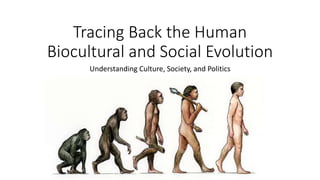
Tracing Human Evolution and Cultural Development
- 1. Tracing Back the Human Biocultural and Social Evolution Understanding Culture, Society, and Politics
- 3. Charles Darwin •Darwin’s theory of evulotion and natural selection declared that species survived through a process called “Natural Selection,” where those that successfully adapted, or evolved, to meet the changing requirements of thier natural habitat thrived, while those that failed to evovled and reproduce died off.
- 4. The Biological and Cultural Evolution •Ember (2002) explains that one of the most controversial aspects of Darwin’s theory was the suggestion that one species could, over time, evolve into another. •A species is a population that consists of organisms’s able inter-breed and produce fertile and viable offspring.
- 5. The Hominids •It is one of the erliest members of the primate family hominidae, containing humans, their immediate ancestors, and close extinct relatives.
- 6. Early Hominid Tools Stone Tools
- 7. Early Hominid Tools Wood Tools
- 8. Early Hominid Tools Bone Tools
- 14. 4 Physical Features of Hominids • 1. Body Size – enormously body size • 2. Relative Brain Size – larger primates usually have larger brains. Fruit-eating primates tend to have relatively larger brains than leaf-eating primates. • 3. Tool Making – only human primates such as apes use tools, although several species of monkey use “weapon” like branches, stones, or fruit. • 4. Language – Only humans have symbolic spoken language. But early human primates use alarms and sounds.
- 15. Australopithecus
- 16. Australopithecus
- 17. Australopithecus •The First Definite Hominid •Existed 3.6 million years ago •Capable of climbing and moving trees •Bipedalism – They have the ability to walk on two legs
- 18. Homo Habilis
- 19. Homo Habilis
- 20. Homo Habilis •Came from Tanzania, Kenya, and South Africa. •Known to exist around 2 million years ago. •Developed tools primarily for their use in scavenging •Considered to be the more intelligent and organized than the hominids
- 21. Homo Erectus
- 22. Homo Erectus
- 23. Homo Erectus •First found in Java, later in China, and still later in Africa •Meaning “erect ape man” •Evolved after Homo habilis •Existed 1.8 million years ago •They moved from Africa to Asia
- 24. Characteristcs of Homo Erectus • Their skull was generally long, low, and thickly walled with a flat forntal area and prominent brow ridges. • They had relatively small teeth. • They are the first hominid to have third molars. • They had prominent, projecting nose • They are comparable to modern humans’ size.
- 29. Homo Sapiens
- 30. Homo Sapiens
- 31. Homo Sapiens •Evolved from homo erectus •500,000 – 200, 000 years ago •They were also classified as Homo Sapiens Neandertalensis or Homo Neandertalensis by some anthropologist. •Argued to be the evolved into Humans
- 32. A) True or False B) Enumeration 1. What are the tools that early hominids used? Explain the use of each tool. 2. Enumerate the Four (4) Physical Features of Hominids. 3. Identify the four (4) Hominidae Family. Describe each. c) Essay Explain the importance of understanding the biological evolution of man. (10 points) Explain the early lifestyle of the Hominids. (10 points)